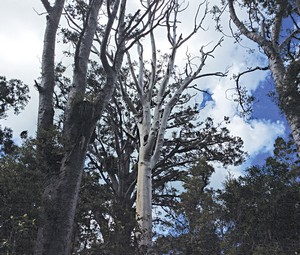Kauri dieback symposium draws communities together
 Over 90 participants from a cross section of the community gathered in Hokianga last month to discuss the latest efforts in the fight against kauri dieback. Research, management, operational aspects and community engagement through the creative arts were all presented, along with a plea from the next generation to “work harder” to find a solution to the disease. Hosting the symposium in Northland, an area that contains many of the country’s remaining ‘old kauri’ forests and where signs of the disease are clearly visible, provided local communities the opportunity to take part.
Over 90 participants from a cross section of the community gathered in Hokianga last month to discuss the latest efforts in the fight against kauri dieback. Research, management, operational aspects and community engagement through the creative arts were all presented, along with a plea from the next generation to “work harder” to find a solution to the disease. Hosting the symposium in Northland, an area that contains many of the country’s remaining ‘old kauri’ forests and where signs of the disease are clearly visible, provided local communities the opportunity to take part.
“There was a real melting pot of views expressed from a broad cross section of communities facing the challenges associated with managing the disease,” says Dr Nari Williams, forest pathologist and leader of Scion’s ‘Healthy trees, healthy future’ programme (HTHF). “Overall, there was a very positive exchange of ideas and it provided an opportunity for scientists to talk about what we are doing in the lab and field, and for us to hear how some of these findings are being applied by local communities actively involved in helping prevent the disease spreading.”
Delegates also took a field trip to nearby Waipoua Forest, home to some of the country’s iconic kauri, the four sisters and giant among giants, Tane Mahuta. The forest is one of the country’s major tourist spots, highlighting even further the significance of these magnificent forests and the economic benefits they offer nearby communities.
Kauri dieback is caused by Phytophthora taxon Agathis, or PTA, a pathogen which is known to affect only kauri. At present, Scion and our collaborators in the HTHF programme are focusing research on screening for PTA resistance, understanding the host-pathogen interactions, and improving diagnostic techniques. Once a tree is infected, it may take years before visible signs of disease are noticeable, often in the form of leaf drop, canopy dieback and sap-bleeding lesions. Quick and accurate diagnosis means management strategies can be put in place that much faster. Scion pathologists are looking at portable devices that will speed up diagnosis by making it possible to confirm the presence of the pathogen in the field rather than transporting infested soil samples to the laboratory for testing; a process that is time consuming, costly and risky.
To understand why PTA is so devastating to kauri, research partners at Landcare Research are using electron and fluorescence microscopy to observe how the pathogens move inside the tree roots of artificially inoculated seedlings. Using these techniques they have observed how PTA grows in and around the root cells of kauri. These observations will be compared to infection by other Phytophthora species to compare mechanisms of infection and ensure selection is made to a wide range of species.
Scion geneticists are optimistic about identifying resistance in the natural population of kauri. Finding natural resistance would provide a glimmer of hope for possible PTA-resistant kauri being bred in the future. Encouragingly, there are early indications that response to PTA infection varies in different populations of kauri.
In the interim, however, Plant and Food Research scientist Dr Ian Horner has found that phosphite may offer some short-term relief for those trees already infected. Phosphite is an inexpensive chemical commonly used in agriculture that helps slow the progression of Phytophthora pathogens. Kauri injected with phosphite show some relief from visible symptoms of the disease but, as Ian stresses, it does not offer a cure.
“The Kauri Dieback Symposium was a great success this year with a lot of positives coming from having a melting pot of ideas,” says Nari. “Like all Phytophthora diseases, kauri dieback is a huge challenge which the HTHF team is endeavouring to tackle by determining what makes some species so virulent on specific hosts. With many key parts of the programme getting into full swing our first research objective is to determine if there is a level of resistance to PTA infection in the kauri population. This analysis will be pivotal to the long-term management of the species”.
For further information
Contact Rebecca McDougal
